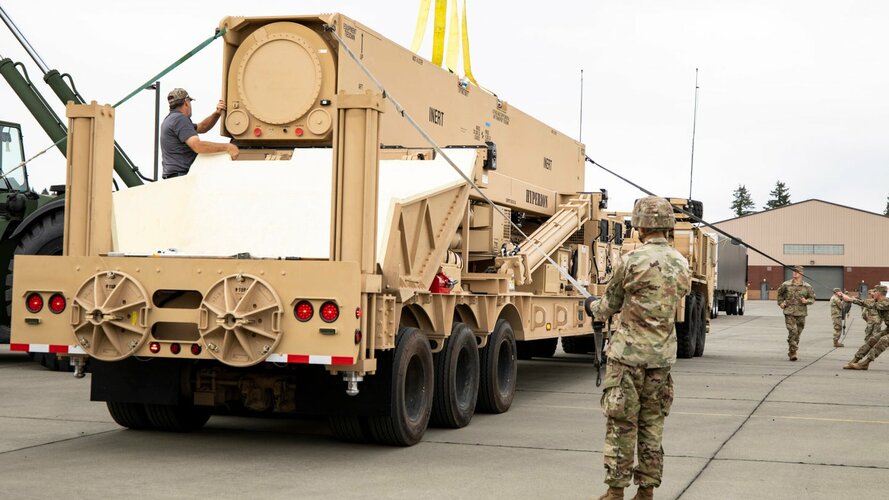- Joined
- 21 April 2009
- Messages
- 13,725
- Reaction score
- 7,606
Not too promising at the moment, to be honest.

 spacenews.com
spacenews.com
I see another example of what’s become very common these days of a senior military man quickly finding work in the private sector. I was reading this is far more common than back even in the eighties and nineties.Make a nice hypersonic strike weapon

Virgin Orbit eyes growth in military ‘responsive’ launch
Virgin Orbit is looking to grow its military business by proving that rockets launched from airplanes in flight can be instruments of national security.spacenews.com
Next phase SciFIRE awards happened today. Both Boeing and Lockheed Martin selected to further their offerings through a PDR.
Raytheon Missiles & Defense, Tucson, Arizona, was awarded a $27,991,408 cost-plus-fixed-fee modification (P00002) to previously awarded contract FA8682-21-C-0010 for the Southern Cross Integrated Flight Research Experiment (SCIFiRE) Project Phase I preliminary design review (PDR). The modification is an option exercise to mature a solid rocket-boosted, air-breathing, hypersonic conventional cruise missile, air-launched from existing fighter/bomber aircraft, through the completion of a (PDR). The location of performance is Tucson, Arizona, and work is expected to be completed by Sept. 2, 2022. This modification does not involve Foreign Military Sales. Fiscal 2020 and 2021 research and development funds in the amount of $1,521,861 and $8,750,000, respectively, are being obligated at the time of award. The total cumulative face value of the contract is $33,698,870. Future Hypersonics, Eglin Air Force Base, Florida, is the contracting activity.
These GOs live to run to the traditional majors to secure "money for nothing and chicks for free"...completely corrupt... of course, half the reason for corporate capture and the collapse of innovation.I see another example of what’s become very common these days of a senior military man quickly finding work in the private sector. I was reading this is far more common than back even in the eighties and nineties.Make a nice hypersonic strike weapon

Virgin Orbit eyes growth in military ‘responsive’ launch
Virgin Orbit is looking to grow its military business by proving that rockets launched from airplanes in flight can be instruments of national security.spacenews.com
Ultra-efficient 3D printed catalysts could help solve the challenge of overheating in hypersonic aircraft and offer a revolutionary solution to thermal management across countless industries.
Developed by researchers at RMIT, the highly versatile catalysts are cost-effective to make and simple to scale.
The team's lab demonstrations show the 3D printed catalysts could potentially be used to power hypersonic flight while simultaneously cooling the system.


Scientific American - The Physics and Hype of Hypersonic Weapons
"These novel missiles cannot live up to the grand promises made on their behalf, aerodynamics shows"

The Physics and Hype of Hypersonic Weapons
These novel missiles cannot live up to the grand promises made on their behalf, aerodynamics showswww.scientificamerican.com
Scientific American - The Physics and Hype of Hypersonic Weapons
"These novel missiles cannot live up to the grand promises made on their behalf, aerodynamics shows"

The Physics and Hype of Hypersonic Weapons
These novel missiles cannot live up to the grand promises made on their behalf, aerodynamics showswww.scientificamerican.com
I've just red it and was ready to post it - when I browsed and found it here. One word: SCATHING !
Well worth a read.
I imagine that’s why for example though they both crept into the light somewhat around the same time the RQ-180 appears to be flying around in the real world whereas the SR-72 seems to remain mostly a paper project.Scientific American - The Physics and Hype of Hypersonic Weapons
"These novel missiles cannot live up to the grand promises made on their behalf, aerodynamics shows"

The Physics and Hype of Hypersonic Weapons
These novel missiles cannot live up to the grand promises made on their behalf, aerodynamics showswww.scientificamerican.com
I've just red it and was ready to post it - when I browsed and found it here. One word: SCATHING !
Well worth a read.
Well, I read it on your recommendation and the article does make a good, well argued case.
What happens at speeds above M5 is somewhat counterintuitive and also, from what I've understood reading about hypersonics here and elsewhere, the true expert/professional community around this subject isn't very numerous so the dynamics between military/policy and technology aren't all that straightforward. It's a real risk that we're accumulating distrust and other adverse proliferation on a mirage. Jeffrey "Arms Control Wonk" Lewis has for a long time offered similar critiques on the subject, not to mention that disambiguating intent (e.g. conventional vs. nuclear) in using hypersonic weapons doesn't seem quite as straightforward as its proponents would have us believe.
Nonetheless, I've found the recent Australian work particularly interesting, especially when it comes to civilian applications.
In particular it highlighted something I've aleays suspected - that 'maneuverability' will actually come at great costs to speed/range in gliders. That means deviating from your establish flight path comes at a fair cost and with a long lead time (ie, it is not reactive, only pre planned) such that interception during the mid course phase might be very practical - if you don't change trajectories, you're pretty much just a very slow LEO satellite. I suspect in the future one of the main anti-hypersonic weapons will be other hypersonics in the form of scramjets that are less expensive, air launched, and make intercept before the perceived threat envelope of the launching entity. Given a good enough tracking solution provided by satellite, that shouldn't really be a very difficult goal. If a glider has to start its maneuvering to avoid interception shortly after launch, then at the least range and terminal speed on target will be eaten up for the rest of the flight.

I think it depend on what sort of speed.Since 1975 stealth has won nearly every single match against speed. S-300 and S-400 won't help "speed" case anytime soon.
In particular it highlighted something I've aleays suspected - that 'maneuverability' will actually come at great costs to speed/range in gliders. That means deviating from your establish flight path comes at a fair cost and with a long lead time (ie, it is not reactive, only pre planned) such that interception during the mid course phase might be very practical - if you don't change trajectories, you're pretty much just a very slow LEO satellite. I suspect in the future one of the main anti-hypersonic weapons will be other hypersonics in the form of scramjets that are less expensive, air launched, and make intercept before the perceived threat envelope of the launching entity. Given a good enough tracking solution provided by satellite, that shouldn't really be a very difficult goal. If a glider has to start its maneuvering to avoid interception shortly after launch, then at the least range and terminal speed on target will be eaten up for the rest of the flight.
Not all are created equally. From the 60s:
View attachment 664010
How about boost and cruise as the differentiator??This is why discussing 'hypersonic' as a single group is so misleading. Most any ballistic missile of any appreciable range is hypersonic, even a Scud. And there are maneuvering re-entry vehicles for out of atmo BMs. I think we narrow terms down to 'boost-glide' and 'scramjet' to avoid confusion - those two are unambiguously more flat trajectory items and quite honestly the two have almost nothing in common except they go fast.
I still think a scramjet and a boast/glide are vastly different things, even if both initially use a solid rocket booster. The physics of keeping something that starts at Mach 20 alive differ pretty wildly from the physics of keeping a scramjet lit but otherwise operating in an envelope not unlike that of a high performance AAM launched from a fighter in a high speed run.How about boost and cruise as the differentiator??This is why discussing 'hypersonic' as a single group is so misleading. Most any ballistic missile of any appreciable range is hypersonic, even a Scud. And there are maneuvering re-entry vehicles for out of atmo BMs. I think we narrow terms down to 'boost-glide' and 'scramjet' to avoid confusion - those two are unambiguously more flat trajectory items and quite honestly the two have almost nothing in common except they go fast.
Almost certainly. Also note the HIGHEST it flew was 130,000 feet. Most of the flight was significantly lower than that. They didn't do it because there was nothing really that could shoot down an ICBM in those days. If this kind of stuff interests you you might be interested in this book, where the info came from:In particular it highlighted something I've aleays suspected - that 'maneuverability' will actually come at great costs to speed/range in gliders. That means deviating from your establish flight path comes at a fair cost and with a long lead time (ie, it is not reactive, only pre planned) such that interception during the mid course phase might be very practical - if you don't change trajectories, you're pretty much just a very slow LEO satellite. I suspect in the future one of the main anti-hypersonic weapons will be other hypersonics in the form of scramjets that are less expensive, air launched, and make intercept before the perceived threat envelope of the launching entity. Given a good enough tracking solution provided by satellite, that shouldn't really be a very difficult goal. If a glider has to start its maneuvering to avoid interception shortly after launch, then at the least range and terminal speed on target will be eaten up for the rest of the flight.
Not all are created equally. From the 60s:
View attachment 664010
Wow, I'd never heard of that test. I'm guessing the reason it wasn't pursued is that it wasn't considered especially cost effective to have a tiny object like that require an ICBM booster level of energy when simple ballistic delivery was effectively unstoppable anyway. But interesting that they even performed tests. Navigation in that day and age must have been very marginal; ICBMs use astrogation which would clearly be unavailable. I assume this just used INS?




Air Force’s top civilian hints at changes to hypersonic weapons programs
Air Force Secretary Frank Kendall isn't sure the Air Force is developing the right hypersonic missiles.www.defensenews.com
This is not likely to end well.

Has he been in a bubble? RAND did a study back in 1992 I believe about prompt conventional strike. Given nuclear arms reductions anticipated the US would have all these “extra” ballistic missiles and RAND said “hey they’re really accurate how about CPGS missiles?”These GD idiots never change. Same thing back in the days of RATTLRS, HyFly, etc. Basically, "we don't have a use for them if they work".
"“It’s pretty clear to me what the Chinese want to do with the hypersonics they’re developing. It’s even pretty clear to me what the Russians might want to do with hypersonics,” Kendall said.
“The target set that we would want to address, and why hypersonics are the most cost effective weapons for the U.S., I think it’s still to me somewhat of a question mark,” he added. “I haven’t seen all the analysis that’s been done to justify the current program.”"
Hellooo McFly. Why wouldn't we want to, you know, do those same kinds of things?
"Although the Air Force’s work on hypersonic weapons is progressing, it’s not moving fast enough, Air Force Secretary Frank Kendall told reporters at the Air Force Association’s Air, Space and Cyber conference."
Let me guess. Cancelling them and starting over would result in hypersonic weapons on the ramp sooner, right? Right? I'd underestimated the amount of dumbth out of this general when I compared him to the Keystone Cops. Obviously I gave him too much credit.
URL unfurl="true"]https://www.defensenews.com/air/2021/09/22/air-forces-top-civilian-hints-at-changes-to-hypersonic-weapons-programs/[/URL]
This is not likely to end well.
Well they still think Tomahawk is superior to LRASM, (And Brahmos, Zircon, Shipwreck, Vulkan, Sizzler, etc.)URL unfurl="true"]https://www.defensenews.com/air/2021/09/22/air-forces-top-civilian-hints-at-changes-to-hypersonic-weapons-programs/[/URL]
This is not likely to end well.Why do I have the feeling that all hypersonic program will be cancelled then they will go with a "less risk", "mature" option of subsonic cruise missile?.
I sure hope so. The distinct lack of follow through on, well, every other hypersonic program we've ever done tends to make me pessimistic on this topic.A lot on this is being overblown.





